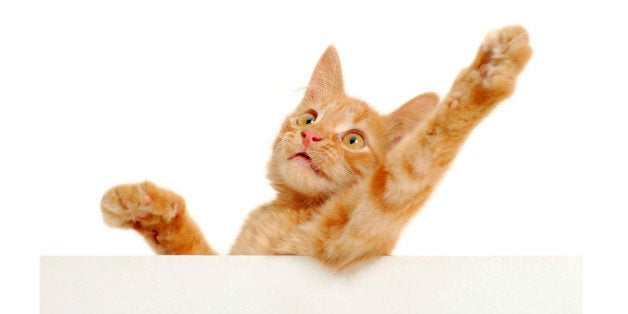
"Millie, the cat scratched the wall again! If she does it one more time, she is O-U-T, OUT! Period!" No, it's no fun to hear that "skritch, skritch, scritch" sound as you find your cat standing with her claws embedded into the fabric (or leather) of your favorite recliner or that one spot on the wall.
You have some options open to you that go beyond taking your feline to the animal shelter or rehoming her. First, learn just why all cats scratch. Second, learn to trim her claws -- it's not hard at all! Invest in several tall, sturdy scratching posts and situate them strategically throughout the house. Declaw her (!). Or buy a package of vinyl claw sheaths and put them on her claws.
What Declawing Truly Is
Many pet owners who love their cats and dogs wouldn't consciously do harm to them. Thus, when they start thinking of declawing their precious little Tigger, because the cat is scratching heck out of the furniture, they may not realize just what this procedure involves. They may believe that only the cat's claws are permanently removed. They may also believe that, once the cat recovers from anesthesia and surgery, she won't feel any aftereffects -- much less long-term or permanent ones.
Declawing your cat actually means that you're going to allow the vet to amputate the last bone of each "finger" of your cat's paws, according to the University of St. Francis. Your cat is put under full anesthesia for this surgery and, when she comes out of recovery, she may need significant pain medication, especially when she tries to resume her usual activities. From walking and running to jumping and even scratching the litter in her litter box, she could experience so much pain that her personality changes.
Look at how gracefully she jumps to a table or surface to lie in the sun. That walk or run she sports is so smooth, with every movement and muscle coordinated just so. If you decide to have her claws surgically removed, she'll be forced to change how she walks and jumps.
Why Cats Scratch
Your cat isn't scratching because she intends to be "bad." She's actually carrying out a long-ingrained and instinctive behavior that all felines, even wild big cats, do. Here are several reasons for her behavior:
º Exercise and stretching
º Removing the dead husks from her claws
º Marking "her" territory
After a long nap, your cat has to stretch her muscles. The easiest way for her to do this is to reach way up high, embed her claws into something and pull down.
Your cat's claws develop husks made up of dead skin cells and she needs to get rid of this. Via scratching.
Her paws have scent glands, according to the Cornell Feline Health Center. She uses the scent from these glands to "mark" her territory, such as the furniture, wood floor, carpet and walls.
Trimming Her Claws is Easy
You trim your fingernails and toenails fairly regularly and it's something you're pretty used to doing. As long as you keep the trimmers away from the quick of your nails and you don't trim so the nail grows into the skin, the procedure is absolutely painless.
So it is for your cat. If the thought of holding a feline with 20 sharp claws gives you heart failure, that's natural. Grip your resolve in your hands and realize you're much bigger than the cat. You can do it! Here's how:
Make your cat a "kitty burrito" by wrapping her in an old bath towel so she can't get away from you. Make like an octopus and wrap both arms around her body so she can't squiggle away.
Reach into the "burrito" and pull just one paw out. Gently squeeze one "finger" of her paw so the claw extends itself. Slip the trimmer over the sharp, narrow end and trim ONLY the clear part. Stay away from the pink area, which is her version of your quick. Press down quickly on the trimmer and "click!" One claw gone. Repeat for the remaining four claws and even her dewclaw (thumb).
Give your girl a treat and a break. Allow her to relax then, pick her up and put her into the burrito again. Trim the second paw. Whew! You're done and everyone survived! Release her from her burrito and she's done. Give her another treat and lavish praise. You'll need to repeat this process two to four weeks from now. Some cats are totally cool with this while others may fight at first.
That Pain-Free Alternative and Scratching Posts
Let's talk scratching posts first. While the fabric-covered posts look more attractive, her claws can get caught in the carpet loops. Go for the sisal-covered posts instead.
Make sure the post is at least as tall as she is when she stretches and puts her arms over her head. It should also have a sturdy base so it won't fall when she scratches. Look where she has scratched in the past. Rub catnip over the sisal and place the post close to an area where she's scratched previously. As she gets used to the post, move it gradually to an area where you want it to stay, recommends The Ohio State University College of Veterinary Medicine.
Buy claw covers (vinyl) and, after you've trimmed her claws, get someone's help so you can cover those claws with the claw caps. This involves inserting a small amount of glue into the cap, then sticking it on a claw.
Size does matter. Go by the sizing chart on the package of covers so you get the most appropriate size for your kitty-girl. They last four to six weeks before falling off naturally. It's easy to apply a new cover.
